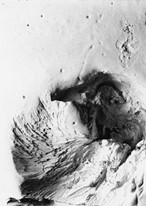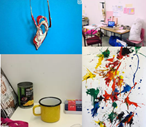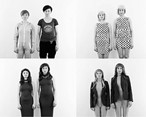The Interaction Design programme at The Glasgow School of Art combines technology with visual thinking and creative problem-solving. As a student of Interaction Design, you will learn to work with creative code to generate engaging interactive digital media for a wide range of platforms. You will graduate with a diverse range of skills enabling future career opportunities in interactive art, design, motion graphics, app development and more.
We are characterised by actively engaging with creative coding and digital culture. The course is highly experimental allowing students to develop their own approaches within an art and design context. We consider our materials to be computers, cameras, sensors, lights, motors, projectors, networks and more. By framing the use of technology within a creative context, students learn practical and technological skills as well as how to articulate creative ideas and meaning behind work.
Benefits of Interaction Design include:
- Ability to bridge both the creative and technological worlds
- Varied graduate destinations such as museum interactives creators, VR developers, graphic designers, new media artists
- Studying in an open, bright, shared and agile space
- Access to great shared facilities: computers, audio facilities, VR, rapid electronic prototyping using Physical Computing, 3D printing, and more.
Live Projects and external partners
The programme aims to include at least one project per year in year 3 which involves working with real-world clients and collaborators. Past examples are such projects are the live-streamed Dream On performance event with The Royal Conservatoire of Scotland and the BBC Scottish Symphony Orchestra in 2017, Glasgow Vintage Vehicle Trust AV installation in 2018, and Glasgow Central Station Tours in 2020. We have strong connections to key digital media industries such as engineering companies, motion graphics and interactive media agencies and have a wide range of international visiting lecturers and guest speakers. This network of partners also facilitates student internships and work experience opportunities.
General monitorship
Students requiring learning support are fully accommodated with agile teaching practice tailored to individual needs. Each student also is assigned a departmental contact tutor who acts in an advisory and pastoral capacity in relation to progress.
Degree Show and beyond
The final year project culminates in an end of year GSA Degree Show, a large-scale and key annual cultural event attracting attention from public and professionals alike. Post-degree show there is an opportunity for students to participate in a group graduate exhibition in London – New Designers. This week-long event is hugely attended and often results in students making contact with employers and collaborators.
Preparing a portfolio
All folios for any art school application should demonstrate involvement with traditional materials and methods such as drawing, mark-making, explorations of colour, form, structure, etc. We seek applicants with questioning and analytical approaches as these fit well with our teaching. An engagement with the wider subject area of digital culture is very attractive to us as is an interest in the creative application of technology. We do not require you to have previous coding experience in order to apply, however we do look for a willingness to actively engage in the learning of these new and challenging creative skillsets.
Hardware and Software Costs
As a student of Interaction Design you should aim to be digitally agile. This usually means using a laptop computer which allows flexibility and ambition in approach to briefs. Your GSA email grants you significant reductions in the cost of a new laptop and the use of flexible payment plans. Your GSA email facilitates the use of free educational licenses of some software including Autodesk Maya and Maxon Cinema 4D.
Design History and Theory
An element of the programme is delivered by the department of Design History and Theory. For most of the four years of undergraduate programmes in design, one day per week of the student timetable is allocated to Design History and Theory. It is an externally linked critical mass of diverse research expertise in broad-based critical studies for contemporary creative practices in design. More information on the department and staff profiles can be found here.












